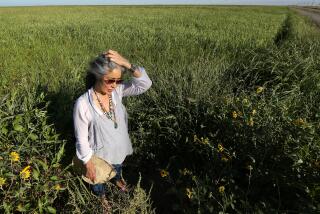RICE : STALKING ITS ORIGINS
- Share via
That steaming bowl of rice that tastes so good with roast duck and sauteed prawns in lobster sauce at your favorite Chinese restaurant traces its ancestry back 9,000 years and beyond.
China was the cradle of domesticated rice, which transformed nomadic hunter-gatherers into settled farmer-laborers, according to Richard S. MacNeish, a prominent American archeologist who has been excavating in China since 1993 in an unusual joint venture with the government.
“The Chinese civilization wouldn’t exist if it hadn’t been for rice,” MacNeish said during a recent stopover in Los Angeles on his way back to China for further excavation.
“It’s all because of domesticating rice that people began to live in the same place.”
MacNeish, head of the Andover Foundation for Archaeological Research and former a Boston University professor, has long sought the origin of rice, the principal food of half of the world.
A specialist in agricultural archeology, he is credited with discovering the earliest sites where corn, pumpkins and other crops were domesticated in the Americas.
Since he earned a doctorate from the University of Chicago nearly half a century ago, the 78-year-old archeologist has dug in rough terrain the world over. He has published more than 300 books and articles.
“I’ve crawled in and out of more caves than a Neanderthal caveman,” said MacNeish, who is also credited with finding a cave in New Mexico that may contain evidence--a handprint on a clay hearth--of the first humans in the Americas, perhaps 40,000 years ago.
Since 1993, MacNeish has been co-leader of the cooperative U.S.-China archeological project that was approved by China’s Bureau of Cultural Relics in 1992. Archeologist Yan Wenming of Beijing University is his Chinese counterpart.
The Chinese government’s involvement has allowed MacNeish access that is rarely extended to an outside researcher.
Working with Yan and their team of 50 Americans and Chinese, MacNeish has unearthed evidence of wild rice going back 16,000 years and domesticated rice dating back 9,000 years.
The proof--fragments of crude pottery, chipped stones, bits of bone and remains of ancient rice plants--was dug from the floors of two caves in a valley near Nanchang, the capital of Jiangxi province in southeastern China.
“Some of the ladies were very bad cooks and burned the rice in the clay pots they were using,” MacNeish joked.
But microscopic analysis of burned rice remnants enabled the team to conclude that rice cultivation began in China.
MacNeish said the two caves where the team has been digging contain layers that show a sequence from 6,000 to 30,000 years ago--from early food producers all the way back to the hunters and food collectors.
“About 16,000 years ago to 13,000 years ago, [the] ice age came to an end and big animals disappeared,” the archeologist said. “So hunters began to collect wild rice and plants for food.”
Then, about 10,000 years ago, someone discovered a freak rice, the precursor of domesticated rice, he said. And cultivation of rice in paddies followed about 9,000 years ago.
Unlike wild rice plants, with one stalk and one tassel, the freak had five stalks, which meant a yield of five times as much food, he said.
Humans, just as curious then as now, experimented by planting the freak.
“They liked the result,” MacNeish said. “It was less work and more food.”
Then they tried planting it in wet areas.
“That was 9,000 years ago and the start of a rice paddy,” he said.
About this time, people also figured out that if they planted seeds in the ground, they could get other types of food.
“Soon there was enough food for people to live in one spot all year long,” MacNeish said. They planted more food, stayed put and lived longer. They are farmers in a village.”
Microscopic tests of soil samples from the caves have revealed individual cells called phytoliths that can clearly be identified as coming from rice plants, MacNeish said.
Also, an analysis of carbon and nitrogen found in a human bone from the cave provided independent evidence that it came from a person who ate mostly rice, he said.
Researchers can determine the age of a fossil by measuring the amount of carbon-14 it absorbed from the atmosphere while it was alive. MacNeish explained that when humans ingest plants, they take in carbon that goes into the bones. Different plants have distinct ratios of the isotopes of carbon, and these proportions remain in the bone and can provide a record of a person’s main diet, according to MacNeish.
“Rice has a very distinctive signature,” he said.
The carbon-dating method has been used to analyze the diets of prehistoric people in New Mexico, he said.
Until a decade ago, it was believed that rice was first domesticated in Southeast Asia, near today’s Myanmar and Thailand, MacNeish said. But thanks to the burned rice found in the caves, China gets to claim the distinction, he said.
“China is very happy,” he said. “It’s a matter of national prestige.”
On his current trip, MacNeish is planning three excavations in the same region.
He wants to find more data on the early pottery and get more accurate dates. He also wants to dig through layers of villages that were built on top of one another over time.
Mounds containing fossil layers from 25 time periods beckon him, MacNeish said. Each layer gives a glimpse of history, from 25,000 years ago to the Shang Dynasty, which is estimated to have lasted from 3,597 to 3,060 years ago, when the first cities were established.
What next?
“If I live long enough,” MacNeish said, “I’ll go find early wheat and barley.”
More to Read
Eat your way across L.A.
Get our weekly Tasting Notes newsletter for reviews, news and more.
You may occasionally receive promotional content from the Los Angeles Times.










